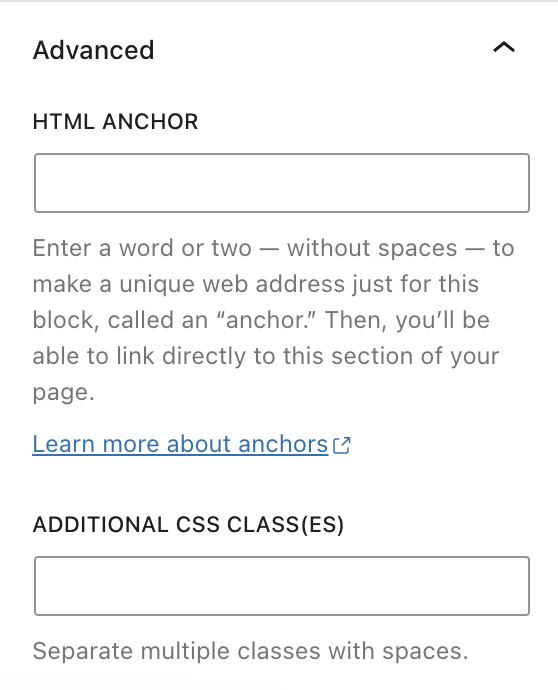Blocks in the WordPress editor contain some advanced settings. This guide will explain how to use these settings.
In this guide
When you select a block, you will find additional block settings in the right sidebar. If you do not see the sidebar, you may need to click the Settings icon in the top-right corner to bring up the settings. This icon looks like a square with two uneven columns:

The Advanced settings are nested under the “Advanced” section of the block settings at the very bottom.
Note that not every block includes all advanced settings described in this guide. The available settings will vary depending on the theme and the type of block.

Create an HTML anchor to create a hyperlink or page jump. Check our full guide to learn how to create anchor links.
Add a CSS class to your block, letting you write custom CSS to style the block as you wish. Check our full guide to adding additional CSS classes to blocks.
You can assign a new name to a block as it appears in List View. The block name is visible only in the editor and does not appear publicly.
For some blocks, when they are used in a synced pattern, you can tick the box labeled “Allow instance overrides.” Currently, the blocks that can be overridden are Paragraph, Heading, Image, and Button blocks.
This allows specific blocks within a synced pattern to be quickly modified after you insert that pattern. When you edit a block with this setting applied, your edits will affect that instance of the synced pattern only. It will not affect the original pattern or other instances where that synced pattern has been inserted.
For example, let’s say a blogger has a ‘Recipe’ pattern. They can insert this pattern into multiple posts, ensuring that the layout and styling components, such as the overall design of the recipe, remain consistent across every post. Meanwhile, they could allow instance overrides for specific parts of the content, such as Ingredients and Steps since those would be specific to each recipe post. Additionally, the blogger would then be able to revisit and modify the overall design of the recipe pattern without affecting the content in individual instances.
To allow overriding specific blocks in a synced pattern:
- Edit your synced pattern.
- Click on a block that allows pattern overrides (currently the Paragraph, Heading, Image, and Button blocks).
- Open the block settings sidebar.
If you do not see the sidebar on the right, click the Settings icon in the top right corner to bring up the settings. This icon looks like a square with two uneven columns:

- Click on the “Advanced” section at the bottom to reveal the advanced settings.
- Tick the box labeled “Allow instance overrides.”
If you make changes to a specific block in the synced pattern that you wish to undo, you can click the “Reset” option in the block’s toolbar to immediately restore it back to the original content.
Depending on the block, you may have access to additional advanced settings:
- HTML Element: Assign an HTML element to the block.
- Remove top/bottom spacing: Remove any margin from the top or bottom of the block.
- Title attribute: Describe the role of an image on a page.
- Link rel: Add a
relattribute such asnofollow. - Styles – Apply globally: Apply the block’s typography, spacing, dimensions, and color styles to all blocks of that type.